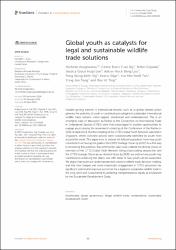Mostrar el registro sencillo del ítem
Global youth as catalysts for legal and sustainable wildlife trade solutions
| Licencia | This is an open access article distributed under the terms of the Creative Commons Attribution License (CC BY). | es |
| Autor | Anagnostou, Michelle | |
| Autor | Yuan Ng, Celine Boon | |
| Autor | Cepeda, Robin | |
| Autor | Huiyi Lee, Jessica Grace | |
| Autor | Beng Loo, Adrian Hock | |
| Autor | Keith Ng, Peng Xiong | |
| Autor | Sitjar, Keanu | |
| Autor | Steffi Tan, Hui Min | |
| Autor | Tang, Yong Jen | |
| Autor | Ting, Wai Kit | |
| Fecha de admisión | 2025-05-04T15:00:14Z | |
| Fecha disponible | 2025-05-04T15:00:14Z | |
| Año | 2025 | |
| Citación | Anagnostou, M., Ng, C. B. Y., Cepeda, R., Lee, J. G. H., Loo, A. H. B., Ng, P. X. K., ... & Ting, W. K. (2025). Global youth as catalysts for legal and sustainable wildlife trade solutions. Frontiers in Conservation Science, 6, 1553549. Recuperado de: | es |
| URI | https://bvearmb.do/handle/123456789/6163 | |
| Sinopsis | Despite gaining traction in international forums, such as in global climate action spheres, the potential of youth in contributing to a legal and sustainable international wildlife trade remains under-tapped, overlooked and underexplored. This is an emerging topic of discussion, as Parties to the Convention on International Trade in Endangered Species (CITES) were first encouraged to explore opportunities to engage youth during the seventeenth meeting of the Conference of the Parties in 2016. In April 2024, the first meeting of the CITES Global Youth Network was held in Singapore, where concrete actions were collaboratively identified by youth from around the world. This paper aims to answer the following question: how may youth contribute to achieving the goals of the CITES Strategic Vision by 2030? As a first step in answering this question, this community case study collates the diverse voices of members of the CITES Global Youth Network. Using a backcasting perspective, and the CITES Strategic Vision as our desired future by 2030, we outline how youth may contribute to achieving the Vision, and offer ideas of how youth can be supported. We argue that youth are underrepresented voices in wildlife trade decision-making, and that their deeper and more meaningful engagement in CITES processes has significant potential to improve outcomes for a legal and sustainable wildlife trade in the long-term and fundamental to achieving intergenerational equity as envisioned by the Sustainable Development Goals. | es |
| Idioma | English | es |
| Publicado | Frontiers in Conservation Science, 6, 1553549 | es |
| Derechos | © 2025 Anagnostou, Ng, Cepeda, Lee, Loo, Ng, Sitjar, Tan, Tang and Ting. | es |
| URI de derechos | http://creativecommons.org/licenses/by/4.0/ | es |
| Materia | Biodiversidad | es |
| Materia | Fauna | es |
| Materia | Hábitats y especies | es |
| Materia | Especies amenazadas o en peligro de extinción | es |
| Materia | Gestión ambiental - Políticas y normas | es |
| Materia | Gestión ambiental - Legislación y Derecho | es |
| Materia | Gestión ambiental - Planificación | es |
| Materia | Objetivos de Desarrollo Sostenible (ODS) | es |
| Título | Global youth as catalysts for legal and sustainable wildlife trade solutions | es |
| Tipo de material | Article | es |
| Tipo de contenido | Scientific research | es |
| Acceso | Open | es |
| Audiencia | Technicians, professionals and scientists | es |
Ficheros en el ítem
Este ítem aparece en la(s) siguiente(s) colección(es)
-
Investigación ambiental [1693]


